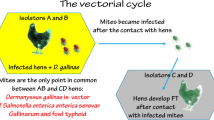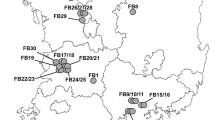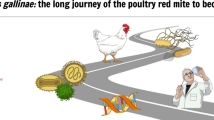Abstract
The vector potential of the poultry red mite, Dermanyssus gallinae De Geer (Acari: Dermanyssidae), in relation to chicken erysipelas was investigated under experimental conditions. Chickens were inoculated intramuscularly with the bacterium Erysipelothrix rhusiopathiae, and mites were allowed to feed on the inoculated chickens for 5 days. After 20 days of starvation, the mites were allowed to feed on healthy chickens to enable transmission of bacteria. Blood samples were collected from the birds and analysed for the presence of E. rhusiopathiae, and ELISA tests were performed for seropositivity. The internal presence of E. rhusiopathiae in the mites after feeding of inoculated birds was also investigated. It could not be demonstrated that mites take up and transmit E. rhusiopathiae under the experimental conditions described. However, since there are case reports as well as other in vitro studies indicating the potential of D. gallinae to act as a reservoir and potential vector for infections agents, we cannot exclude the possibility that the red poultry mite transmits E. rhusiopathiae between chickens under field conditions.

Similar content being viewed by others
References
Blackmore DK, Gallagher GL (1964) An outbreak of erysipelas in captive wild birds and mammals. Vet Rec 76:1161–1164
Bricker JM, Saif YM (2003) Other bacterial diseases, Erysipelas. In: Saif YM (ed) Diseases of poultry. Blackwell Publishing Company, Iowa, pp 812–816
Brockis DC (1980) Mite infestations. Vet Rec 107:315–316
Chauve C (1998) The poultry red mite Dermanyssus gallinae (De Geer, 1778): current situation and future prospects for control. Vet Parasitol 79:239–245
Chirico J, Eriksson H, Fossum O, Jansson D (2003) The poultry red mite, Dermanyssus gallinae, a potential vector of Erysipelothrix rhusiopathiae causing erysipelas in hens. Med Vet Entomol 17:232–234
De Luna CJ, Moro CV, Guy JH, Zenner L, Sparagano OA (2009) Endosymbiotic bacteria living inside the poultry red mite (Dermanyssus gallinae). Exp Appl Acarol 48:105–113
Durden LA, Linthicum KJ, Monath TP (1993) Laboratory transmission of eastern equine encephalomyelitis virus to chickens by chicken mites (Acari: Dermanyssidae). J Med Entomol 30:281–285
Eriksson H, Jansson DS, Johansson KE, Baverud V, Chirico J, Aspan A (2008) Characterization of Erysipelothrix rhusiopathiae isolates from poultry, pigs, emus, the poultry red mite and other animals. Vet Microbiol 137:98–104
Guy JH, Khajavi M, Hlalel MM, Sparagano O (2004) Red mite (Dermanyssus gallinae) prevalence in laying units in Northern England. Br Poult Sci 45(Suppl 1):S15–S16
Höglund J, Nordenfors H, Uggla A (1995) Prevalence of the poultry red mite, Dermanyssus gallinae, in different types of production systems for egg layers in Sweden. Poult Sci 74:1793–1798
Hollifield JL, Cooper GL, Charlton BR (2000) An outbreak of erysipelas in 2-day-old poults. Avian Dis 44:721–724
Kilpinen O (2001) Activation of the poultry red mite, Dermanyssus gallinae (Acari: Dermanyssidae), by increasing temperatures. Exp Appl Acarol 25:859–867
Kirkwood A (1963) Longevity of the mites Dermanyssus gallinae and Liponyssus sylviarum. Exp Parasitol 14:358–366
Mazaheri A, Lierz M, Hafez HM (2005) Investigations on the pathogenicity of Erysipelothrix rhusiopathiae in laying hens. Avian Dis 49:574–576
McDevitt R, Nisbet AJ, Huntley JF (2006) Ability of a proteinase inhibitor mixture to kill poultry red mite, Dermanyssus gallinae in an in vitro feeding system. Vet Parasitol 141:380–385
Murase N, Suzuki K, Nakahara T (1959) Studies on the typing of Erysipelothrix rhusiopathiae II. Serological behaviours of the strains isolated from fowls including those from cattle and humans. J Pr J Vet Sci 21:177–181
Mutalib AA, King JM, McDonough PL (1993) Erysipelas in caged laying chickens and suspected erysipeloid in animal caretakers. J Vet Diagn Invest 5:198–201
Sparagano O, Pavlicevic A, Murano T, Camarda A, Sahibi H, Kilpinen O, Mul M, van Emous R, le Bouquin S, Hoel K, Cafiero MA (2009) Prevalence and key figures for the poultry red mite Dermanyssus gallinae infections in poultry farm systems. Exp Appl Acarol 48:3–10
Tucci EC, Prado AP, Araujo RP (2008) Development of Dermanyssus gallinae (Acari: Dermanyssidae) at different temperatures. Vet Parasitol 155:127–132
Valiente Moro C, Chauve C, Zenner L (2007a) Experimental infection of Salmonella Enteritidis by the poultry red mite, Dermanyssus gallinae. Vet Parasitol 146:329–336
Valiente Moro C, Fravalo P, Amelot M, Chauve C, Zenner L, Salvat G (2007b) Colonization and organ invasion in chicks experimentally infected with Dermanyssus gallinae contaminated by Salmonella Enteritidis. Avian Pathol 36:307–311
Valiente Moro C, Thioulouse J, Chauve C, Normand P, Zenner L (2008) Bacterial taxa associated with the hematophagous mite Dermanyssus gallinae detected by 16S rRNA PCR amplification and TTGE fingerprinting. Res Microbiol 160:63–70
Valiente Moro C, De Luna CJ, Tod A, Guy JH, Sparagano OA, Zenner L (2009) The poultry red mite (Dermanyssus gallinae): a potential vector of pathogenic agents. Exp Appl Acarol 48:93–104
Wallgren P, Mattsson S, Stenström I-M, Kugelberg C, Sjögren U (2000) Påvisande av serumantikroppar mot Erysipelothrix rhusiopathiae som diagnostisk metod hos gris. Svensk veterinärtidning 52:69–76
Zeman P, Stika V, Skalka B, Bartik M, Dusbabek F, Lavickova M (1982) Potential role of Dermanyssus gallinae De Geer, 1778 in the circulation of the agent of pullurosis-typhus in hens. Folia Parasitol (Praha) 29:371–374
Acknowledgments
This study was funded by the Swedish Council for Environment, Agricultural Sciences and Spatial Planning (FORMAS). Dr Christian Epe, then of the Institute of Parasitology, University of Veterinary Medicine, Hannover, Germany is acknowledged for providing the mites, Katarina Näslund, Department of Virology, Immunobiology and Parasitology, National Veterinary Institute for performing the ELISA, and Professor Arvid Uggla and Dr David Morrison, Department of Biomedical Sciences and Veterinary Public Health, Swedish University of Agricultural Sciences for valuable comments on the manuscript. The authors are grateful to the staff of the Department of Bacteriology, Swedish National Veterinary Institute, for assistance with the microbiological analyses and the staff at the Department of Animal Health and Antimicrobial Strategies, National Veterinary Institute for providing us with crude antigen for the ELISA.
Author information
Authors and Affiliations
Corresponding author
Rights and permissions
About this article
Cite this article
Brännström, S., Hansson, I. & Chirico, J. Experimental study on possible transmission of the bacterium Erysipelothrix rhusiopathiae to chickens by the poultry red mite, Dermanyssus gallinae . Exp Appl Acarol 50, 299–307 (2010). https://doi.org/10.1007/s10493-009-9317-4
Received:
Accepted:
Published:
Issue Date:
DOI: https://doi.org/10.1007/s10493-009-9317-4




